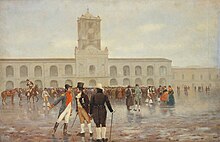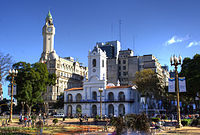| Cabildo of Buenos Aires | |
|---|---|
| Cabildo de Buenos Aires | |
 | |
 The east façade opposite Plaza de Mayo The east façade opposite Plaza de Mayo | |
| Former names | Cabildo de la ciudad de la Trinidad y Puerto de Santa María de Buenos Aires |
| General information | |
| Type | Historic museum |
| Architectural style | Baroque |
| Address | Bolívar 65 |
| Town or city | Buenos Aires |
| Country | Argentina |
| Coordinates | 34°36′32″S 58°22′25″W / 34.60889°S 58.37361°W / -34.60889; -58.37361 |
| Completed | 1748 |
| Renovated | 1880, 1940 |
| Demolished | 1889, 1931 |
| Owner | Government of Argentina |
| Design and construction | |
| Architect(s) |
|
| Website | |
| cabildonacional.cultura.gob.ar | |
| National Historic Monument of Argentina | |
| Designated | 1933 |
The Cabildo of Buenos Aires (Spanish: Cabildo de Buenos Aires) is the public building in the city of Buenos Aires, Argentina, that was used as a seat of the town council during the colonial era and the government house of the Viceroyalty of the Río de la Plata.
The building was also seat of other institutions such as the Royal Audience of Buenos Aires, the highest court for appeal of second instance in the territory, operated from April 6, 1661 to January 23, 1812, when it was replaced by an Appeals Chamber. On September 13, 1810, the Primera Junta created the Public Library of Buenos Aires, being the Cabildo its first location for two years. Nevertheless the institution that worked for longer in that building was the Buenos Aires prison, from 1608 to 1877, when their prisoners were transferred to the missing national penitentiary of Las Heras Street, when it was inaugurated.
The Cabildo was declared National Historic Monument in 1933 and was opened to public as a museum in 1938.
History
First construction
Mayor Manuel de Frías proposed the building of the cabildo in what is now the Plaza de Mayo on March 3, 1608, since the government of the city lacked such a building. Its construction was financed with taxes from the port of Buenos Aires, the building was finished in 1610 but was soon found to be too small and had to be expanded.
The construction of the two humble rooms (the Chapter House and the Prison) was in charge of the builder Juan Méndez, while Hernando de la Cueva was in charge of the braces, Pedro Ramírez of the doors and windows, Hernando Álvarez of the plastering and whitewashing. and some Brazilian roof weavers.
In 1612 the works on the Cabildo were completed, which facilities would later be rented. After two years, and due to the number of prisoners housed, the Cabildo became small and had to be used entirely as a prison, so the meetings of authorities were held in the governor's house and later in the fort.
Because of the lack of maintenance, the building soon fell into deterioration. The original Cabildo began to collapse in 1632, so the construction of a new one was undertaken, which only began in 1635 and lasted for more than five years due to lack of funds. In May 1682, the authorities proposed the construction of a two-floor building, but the project did not progress. As the population began to grow, the building could not hold such a number of people.
Second construction
A project by engineer Domingo Petrarca in 1722 was rejected considering it too expensive. On July 23, 1725, construction of the new building began, according to plans by the Jesuit architects Giovanni Battista Primoli and Andrea Bianchi. Bianchi was responsible for the design of the most notable part: the facade. However the construction was postponed with the departure of the architects to the city of Córdoba in 1728, where they took over works on the Cathedral. Work on the Cabildo was restarted in 1731, by Miguel Acosta and Julián Preciado. In August 1731 the works were restarted, which were suspended again in 1732 due to lack of budget. Thus, the building was handed over for use in 1748, and the tower was added in 1773, although according to other sources, it could have been built in 1764.

After the May Revolution in 1810, when the building served as seat for the congressmen that established the first Argentine government, the cabildo as a political institution continued operating until 1821, when it was dissolved. After that, the historic building continued operating as an administrative office. In 1860, the clock on the tower was replaced by one acquired from English manaufacturer Thwaites & Reed, while the original clock was moved to the Iglesia de Balvanera also in Buenos Aires.
In 1879, the project advanced to install the Civil Chamber in the old building, since the Judiciary did not yet have its own building. Architect Pedro Benoit planned a total renovation that included the elevation of the tower (ten meters) and placing a tiled dome in Nordic style. Colonial red tiles were removed from the roof while the balconies were decorated with balustrades. The entire facade was refurbished to make it look in Italian style. The new Cabildo facade was finished in 1880.
Demolition and rebuilding
In 1889, due to the opening of Avenida de Mayo, three arches on the north side of the building were demolished, with works carried out by architect Juan Antonio Buschiazzo. The tower built by Benoit was also demolished alleging that its excessive weight endangered the stability of the construction. In this way the building lost its frontal symmetry, until in August 1931, when José Félix Uriburu was de facto president, the other three arches on the south side were demolished to harmonize the building with the Julio A. Roca street, despite the widespread protests. Only five of the original arches remained.
The Cabildo was declared National Historic Monument by Law 11,688 in May 1933
Between 1939 and 1940, the architect Mario Buschiazzo reconstructed the colonial features of the Cabildo using various original documents. The tower, the red tiles, the iron bars on the windows and the wooden windows and doors were all reinstalled, using replicas. The last stage of the reconstruction was carried out by architect Alejandro Bustillo. The Cabildo was reinaugurated in October 1940.
Museum
In 1938, the Cabildo was opened as a museum. Currently named "National Museum of the Cabildo and the May Revolution" (Spanish: Museo Nacional del Cabildo y la Revolución de Mayo), objects in exhibition include paintings, artifacts, clothes, and jewelry of the 18th century. The courtyard (patio) of the cabildo still has its 1835 ornamental water well (aljibe).
Galleries
Historical images
-
 Painting by Charles Pellegrini, 1829
Painting by Charles Pellegrini, 1829
-
 First photograph, c. 1852
First photograph, c. 1852
-
 1867 (right)
1867 (right)
-
 After the refurbishments of 1879
After the refurbishments of 1879
-
 During the Centennial of Argentina
During the Centennial of Argentina
-
 In 1915, with north arcs demolished
In 1915, with north arcs demolished
Modern images
References
- ^ El Cabildo on GCBA
- ^ Historia del Cabildo de Buenos Aires on Historia y Biografías
- ^ La Plaza de Mayo, escenario de la vida argentina, by Gutiérrez, Ramón; Berjman, Sonia (1995) – Colección cuadernos del Águila, Fundación Banco de Boston
- ^ Transformaciones del Cabildo by Mabel Crego on Barriada, 5 Jun 2011
- Engel, Emily (2020-03-23). Pictured Politics: Visualizing Colonial History in South American Portrait Collections. University of Texas Press. p. 53. ISBN 978-1-4773-2059-4.
- La Audiencia de Buenos Aires y la Gobernación del Tucumán: tensiones entre políticas provinciales y regionales, 1660-1674 on Revista Historia del Derecho no. 60
- El Museo on Cabildo website
- Biblioteca Nacional Argentina on Ver Buenos Aires
- El Cabildo, la primera cárcel at the SPF
- ^ Ley 11,688: "Declárase monumento histórico nacional al Cabildo de la Ciudad de Buenos Aires.", May 30, 1933
- Slatta, Richard W. (1997). Comparing Cowboys and Frontiers. University of Oklahoma Press. p. 63. ISBN 978-0-8061-2971-6.
- ¿Cómo era el edificio del Cabildo de Buenos Aires? on Ciencia Hoy magazine (archived)
- La historia del Cabildo, un monumento mutilado on Metropolis.com.ar, 24 May 2018
- Los aljibes del Cabildo on Barriada.com.ar, 15 Jan 2007
- Primera foto del Cabildo de Buenos Aires. c. 1852 on Buenos Aires Historia
- Trofeos de la Reconquista de la Ciudad de Buenos Aires en el Año 1806 (in Spanish). Buenos Aires: Litografía, Imprenta y Encuadernación de Guillermo Kraft. 1882.





